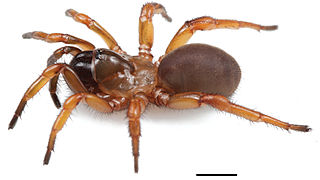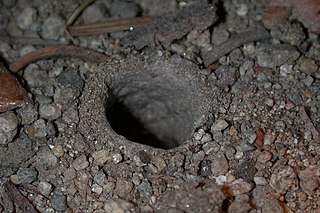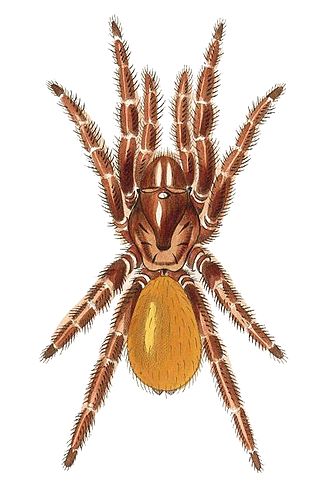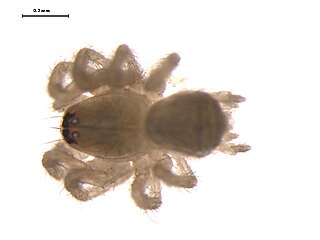
The Mygalomorphae, or mygalomorphs, are an infraorder of spiders, and comprise one of three major groups of living spiders with over 3000 species, found on all continents except Antarctica. Many members are known as trapdoor spiders due to their creation of trapdoors over their burrows. Other prominent groups include Australian funnel web spiders and tarantulas, with the latter accounting for around one third of all mygalomorphs.

Uloboridae is a family of non-venomous spiders, known as cribellate orb weavers or hackled orb weavers. Their lack of venom glands is a secondarily evolved trait. Instead, they wrap their prey thoroughly in silk, cover it in regurgitated digestive enzymes, and then ingest the liquified body.

Ctenizidae is a small family of mygalomorph spiders that construct burrows with a cork-like trapdoor made of soil, vegetation, and silk. They may be called trapdoor spiders, as are other, similar species, such as those of the families Liphistiidae, Barychelidae, and Cyrtaucheniidae, and some species in the Idiopidae and Nemesiidae. The name comes from the distinctive behavior of the spiders to construct trapdoors, and ambush prey from beneath them.

The family Cyrtaucheniidae, known as wafer-lid trapdoor spiders, are a widespread family of Mygalomorphae spiders.

Myrmekiaphila is a genus of North American mygalomorph trapdoor spiders in the family Euctenizidae, and was first described by G. F. Atkinson in 1886. All described species are endemic to the southeastern United States.

Aptostichus is a genus of North American mygalomorph spiders in the family Euctenizidae, and was first described by Eugène Simon in 1891. They are found predominantly in southern California, United States.

Mallos is a genus of cribellate araneomorph spiders in the family Dictynidae, and was first described by O. Pickard-Cambridge in 1902. Among the genus, Mallos gregalis is known to be a social spider species, living in groups and signaling each other by vibrating their web.

Aliatypus is a genus of North American folding trapdoor spiders first described by C. P. Smith in 1908. They resemble members of Ctenizidae in morphology and behavior, but this is due to convergent evolution rather than direct relation. They are most closely related to members of Antrodiaetus, which build collar doors. It is likely that the shift from using collar doors to using trapdoors is what allowed them to survive in hot, dry conditions where their closest relatives could not.

Atypoides is a genus of North American folding trapdoor spiders. It was first described by Octavius Pickard-Cambridge in 1883, and it has only been found in United States. It was synonymized with the genus Antrodiaetus in 2007, but was restored to its former independent status in 2019. As of November 2021, it contains only three species: A. gertschi, A. hadros, and A. riversi.

The Euctenizidae are a family of mygalomorph spiders. They are now considered to be more closely related to Idiopidae.

Eucteniza is a genus of trapdoor spiders in the family Euctenizidae containing at least 14 species occurring in Mexico and the southern United States. Species are distinguished by a softened rear portion of the carapace, and males possess large spines on the first two pairs of walking legs that are used to hold females during mating. Like other trapdoor spiders they create burrows with a hinged lid, from which they await passing insects and other arthropods to prey upon. Many species are known from only one or two localities, or from only male specimens. More species are expected to be discovered. Eucteniza is closely related to spiders of the genera Entychides and Neoapachella.

Entychides is a genus of mygalomorph trapdoor spiders in the family Euctenizidae, and was first described by Eugène Simon in 1888. Originally placed with the Ctenizidae, it was moved to the wafer trapdoor spiders in 1985, then to the Euctenizidae in 2012.
Apomastus is a genus of North American mygalomorph spiders in the family Euctenizidae, and was first described by Jason Bond & B. D. Opell in 2002. As of May 2019 it contains only two species, both found in the Los Angeles Basin of southern California: A. kristenae and A. schlingeri.
Bolostromoides is a monotypic genus of South American wafer trapdoor spiders containing the single species, Bolostromoides summorum. It was first described by R. D. Schiapelli & B. S. Gerschman in 1945, and has only been found in Venezuela.

Neoantistea is a genus of dwarf sheet spiders that was first described by Willis J. Gertsch in 1934.
Conifaber is a genus of spiders in the family Uloboridae. It was first described in 1982 by Opell. As of 2017, it contains 4 species, all from South America:

Waitkera is a genus of spiders in the family Uloboridae. It was first described in 1979 by Opell. As of 2021, it contains only one species, Waitkera waitakerensis, found in New Zealand.

Avicularioidea is a clade of mygalomorph spiders, one of the two main clades into which mygalomorphs are divided. It has been treated at the rank of superfamily.
Cryptocteniza is a monotypic genus of North American mygalomorph spiders in the family Euctenizidae containing the single species, Cryptocteniza kawtak. It was first described by Jason Bond, C. A. Hamilton and R. L. Godwin in 2020, and it has only been found in the United States.














